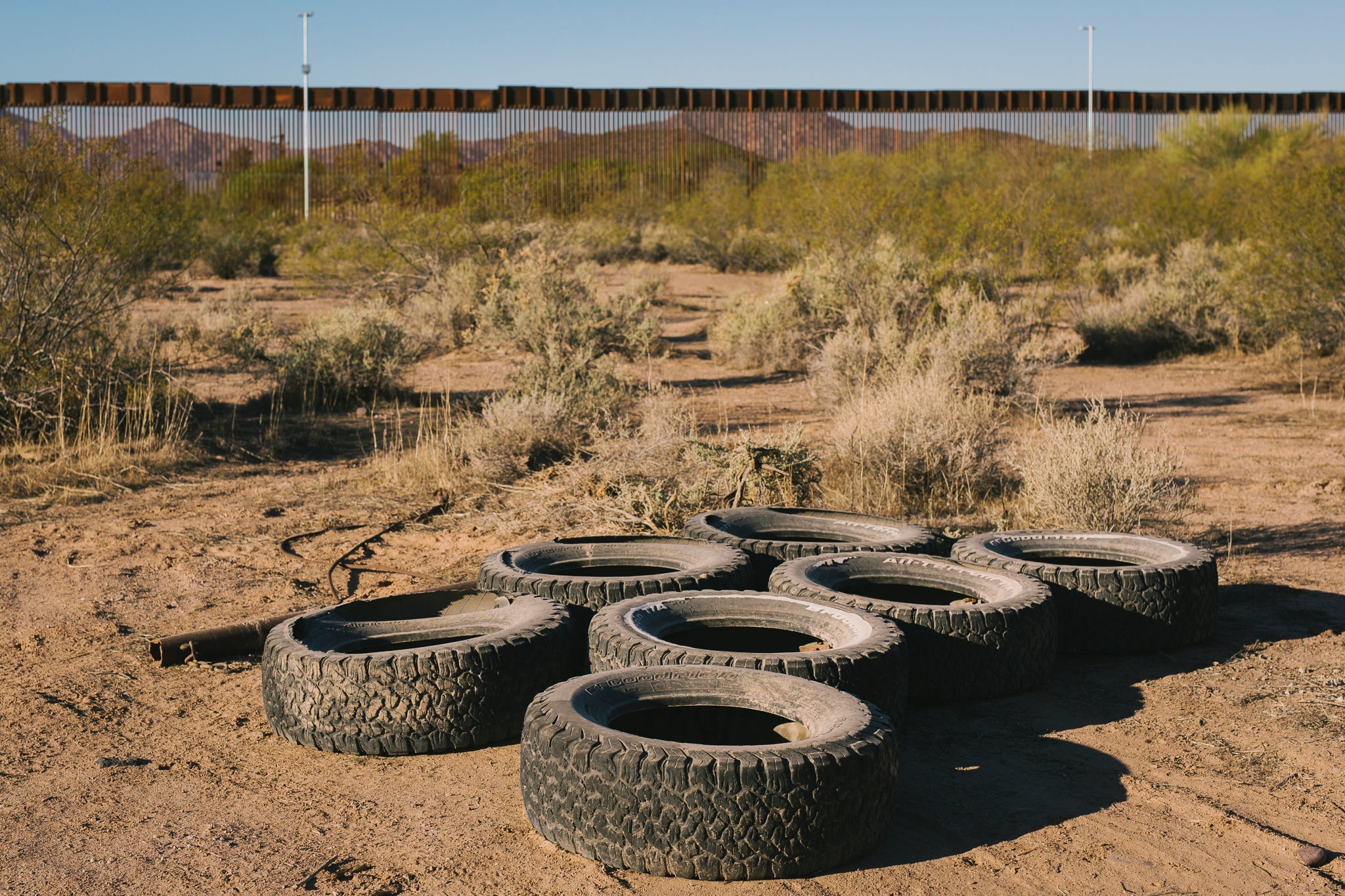I had heard about the human remains found on a regular basis at Organ Pipe Cactus National Monument, bodies of migrants who died trying to cross the Sonoran Desert. I had seen the interactive death map of southern Arizona, where red dots light up throughout the park grounds. So when I saw the group of large birds circling overhead, a bit further down my hiking trail, I braced myself for what I was about to find.
But it was not a dead body—it was an abandoned encampment, with four camo backpacks that had been left there and torn apart by animals. What remained was a heap of trash, blown about by the desert winds. The site itself was a seasonal oasis in the wash along my trail, a little enclave protected by tall palo verde trees and bigger rocks that offered more cover than the rest of the exposed surroundings. The parking lot for the trail I was planning to hike was less than 500 feet away.
Upon closer inspection, I found empty plastic wrappers—chips, nuts, cookies—several rolls of toilet paper, tubes of toothpaste that had been pecked apart by bird beaks, and black plastic water jugs, the dead giveaway that the backpacks came from south of the border. Such old Clorox bottles, painted black in factories so that they don’t reflect light, can be found all over the park.
I decided to pick up one of the backpacks, which was heavier than I expected. Though birds and other animals had already torn parts of it open, I unzipped one of the intact compartments and discovered a full, unopened jar of mayonnaise inside. In the main compartment, another roll of toilet paper. The whole scene looked even dirtier and more chaotic because of white guano all over the rocks, courtesy of the birds circling overhead.
I later reported this to a park ranger in hopes that the trash would be collected immediately, but I learned that this encampment was not unique or even remarkable. Litter is one of the biggest environmental consequences of border activity at Organ Pipe. There are abandoned camps everywhere, and the park service cannot keep up with cleaning them up. They have become a normal part of life at this park. Some are in the most remote areas, where visitors don’t usually venture, while others, like the one I found, are very close to pickup spots like trailhead parking lots.
The irony is that tighter border security—in the form of an increase in the number of agents in the field, better surveillance technologies, a taller border wall, and so on—does nothing to decrease the amount of trash left behind. On the contrary: The more that border crossers have to prepare for a long trip—often made longer because part of Border Patrol’s job is precisely to push them into those more remote areas of the park, in an effort to discourage crossings in general—the more they take with them, and the more trash is left behind. Organ Pipe is not the only park experiencing an explicitly border-related litter problem. Coronado National Memorial has a couple of piles of litter so big, in one of its least accessible, highest locations that is routinely used as a resting spot, that they will have to be airlifted out, according to Jessica Garcia, the park’s physical scientist. (She and the other park service employees quoted in this piece are speaking for themselves, not the National Park Service.)

Many of the objects left behind have been manufactured for crossing in particular and must be shed toward the end of the trip in order for migrants to avoid being identified as such. Matt Stoffolano, chief ranger at Coronado, speaks of a “cottage industry” that produces the gear that coyotes—as human traffickers on the Southern border are commonly called—distribute to migrants, their paying clients. This includes backpacks, camo clothing, the blackened water bottles, and carpet-soled coverings to be worn over one’s shoes in order to keep from leaving footprints in the dirt. The gear is becoming increasingly sophisticated, as is the knowledge of how to prepare and where to go, including where to possibly find water and where to camp—all improvements in response to heightened border security, and all with ever more dramatic effects on the desert wilderness.
But the biggest and most potentially disastrous consequence of this litter crisis has yet to show itself. It is intimately related to the border wall that runs through both Organ Pipe and Coronado, and the hydrological challenges it poses. If the 2021 monsoon rains yield more water than last year—the driest year on record—the litter will be pushed to the wall by the flooding and collect there. In conjunction with loose vegetative material, it will create nothing less than a dam, stopping the water, which normally flows north to south through the floodgates the wall has been equipped with. What that will look like, the damage it will do to the parks, and how the park service will respond all remains to be seen. This is a situation that the National Park Service has never encountered before, and thus no protocol exists for how to prepare for it, according to Rijk Morawe, chief of resources at Organ Pipe.
For now, what border litter shows us is that the migration crisis inside Arizona’s park service units cannot be neatly divided into two halves, a humanitarian crisis and an environmental one. In Organ Pipe and Coronado, these problems are intimately related, and will require unprecedentedly complex solutions, more complex than increased patrolling, better surveillance equipment, and taller fencing.
Because one thing is for sure: The rains are coming.
Future Tense is a partnership of Slate, New America, and Arizona State University that examines emerging technologies, public policy, and society.
